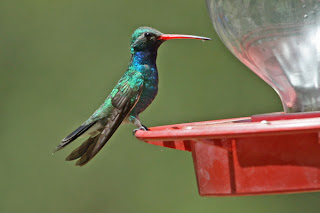I’m just back from leading another excellent Avian Adventures tour in Arizona, my 20th visit to the Grand Canyon State which is this year celebrating its Centennial. Arizona was the last of the contiguous 'Lower 48' states to join the Union in 1912.
The itinerary for our tour was the tried and trusted one that we have followed for quite a number of years. Starting in Tucson and the Santa Catalina Mountains, we concentrated on the south-east of the state, visiting the Chiricahuas, the Huachucas and the Santa Ritas before heading north to Sedona and finally the must-see Grand Canyon itself.
In comparison to some previous tours that have started around the same date as this one (22nd April), the spring migration seemed rather late this year. Every year is different but several species that I would normally expect to find quite easily proved difficult and one or two annoyingly failed to put in an appearance at all until several days after we left or moved out of their range. As always we were compensated by seeing one or two species that I hadn’t expected or ones that I wouldn’t have 'guaranteed'.
I will shortly be writing a full report for the tour participants. Here I will simply share a few photographs…
Owls are always popular, none more so than Burrowing Owl, a member of the same genus, Athene, as the European Little Owl. They seem to have disappeared from some of the sites where I have regularly seen them in the past but this particular bird is one that June and I located when we were in Arizona in January – it was exactly where we left it!
One of six species of wrens that one can reasonably hope to see in Arizona, Cactus Wren is the largest. It has a very distinctive, far-carrying song sounding a bit like a car that is reluctant to start! It is a common bird of the desert, also occurring in Texas, New Mexico, Nevada and California as well as the car parks of our motels in Tucson and Sierra Vista!
An unexpected species was this Common Grackle at John Yerger's feeders at Quailway Cottage, near Portal. It remained for several days attracting a fair bit of local interest as there have been only about a dozen previous records in Arizona of this species from the Eastern USA.
Broad-billed Hummingbirds are always popular with first-time visitors to Arizona as they are one of the easier hummingbird species to identify. We saw nine hummingbird species during the tour; perhaps the absence from that list of Lucifer and White-eared Hummingbirds was a consequence of last year’s wildfires in the Huachucas or maybe they were just late arriving.
It’s not just hummingbirds that benefit from feeders! This is a Ladder-backed Woodpecker but we also saw Acorn, Gila and Arizona Woodpeckers taking advantage.
Always one of the most popular birds on an Arizona tour is Vermilion Flycatcher. Usually associated with water, we saw them along the San Pedro River, at Whitewater Draw, at Willcox Twin Lakes and elsewhere.
This was one of the most obliging Virginia Rails that I’ve ever seen, feeding well away from any cover at Whitewater Draw.
Turkey Vulture was the only species that we saw every day of the tour. Although they look rather like Old World vultures and behave in similar fashion, it is thought that they are not closely related. In fact, some authorities have suggested that they are more closely related to the storks.
Almost everyone I’ve taken to the USA seems to like Red-winged Blackbirds! They are birds that make an impression with their bright red shoulder patches and gurgling calls in the spring and their huge flocks in winter. However, they are considered in some quarters to be a pest species and in 2009 (the most recent year for which I can find figures) almost 1 million of them are reported to have been deliberately poisoned by the US Department of Agriculture, mainly in Texas and Louisiana.
This is a Cassin’s Kingbird. Only Cassin’s and Western Kingbirds made it onto our list this year, although I do think I saw a Tropical at Sweetwater Wetlands. There hadn’t been any sign of a Thick-billed at the traditional site outside Patagonia when we were there.
Lazuli Buntings are migrants through south-eastern Arizona, frequent visitors to feeders on the way from wintering areas in Mexico to breeding territories further north. This one is a colourful male.
We had really great views of several California Condors at the Grand Canyon. In the 1980s the population of these birds in the wild had fallen to 22 individuals, all of them in California. All of those birds were captured and a breeding programme was started which over a period of 20 years has rescued the species from likely extinction. Condors were re-introduced to Arizona in December 1996 after an absence of more than 70 years and they are now breeding in the wild again. There have been setbacks and disappointments along the way and lead poisoning remains a problem, but the future certainly looks much brighter. There are currently about 70 individuals in northern Arizona and southern Utah.
Thanks are due to my companions on this tour for helping to make it so pleasurable and also to many friends in Arizona for their hospitality and their help and advice with the birds.


















No comments:
Post a Comment